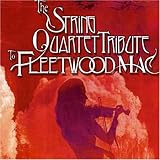See Vitamin String Quartet Live!
Get TicketsThe Little Things
Pink Floyd's "Mother"
Albums that also serve as movie soundtracks (e.g. Pink Floyd’s The Wall) can be expected to have more “human” elements to them, as they’re based on human stories. Some of the non-musical sounds from The Wall movie are left in the accompanying album for a more multi-dimensional sound: From cash registers “cha-chinging” and hearts thumping to school teachers screaming about meat and pudding. I recently noticed a more subtle sound – a deep sigh at the beginning of “Mother.” It’s a fitting auditory relief after the schoolyard chaos in "Another Brick in the Wall Part 2" and a welcoming beacon to the initially soothing musings in “Mother.” While not entirely musical, the sigh fits perfectly within the song.
Fleetwood Mac's "I Don't Want to Know"
Another charmingly human moment in music is the squeak Lindsey Buckingham’s fingers make when they slide down the strings of his acoustic guitar five seconds into Fleetwood Mac’s “I Don’t Want to Know.” Author Chuck Klosterman pointed out this detail in Killing Yourself to Live, calling it “the definitive illustration of what we both loved about music; we loved hearing the inside of a song.” He told this to Wilco’s Jeff Tweedy in an interview. Tweedy agreed, adding that he always thought of Buckingham as someone who wants to control every element of his music, so this little “crack he couldn’t sparkle over” was indicative of the greater truth that “nobody can control anything, really.” It’s amazing what a just a little scratch can do.
The White Stripes – “White Moon”
While The White Stripes' Get Behind Me Satan earned them a Grammy Award and other accolades, it almost didn’t make it to the mixing room. Recorded in Jack White's semi-haunted Detroit home studio, the album seemed to be cursed with failing equipment, leaky ceilings and other misfortunes. Some of these “hauntings” are audible on songs like "White Moon" (a song that even references an ex-girlfriend “ghost”), where drummer Meg White’s bell set falls over with a crash near the end. Giving listeners a hint to the recording location, Jack White's house phone can be heard ringing about 2:50 minutes into "Take Take Take." Looking at more White Stripes songs like Elephant’s "I Wanna Be The Boy To Warm Your Mother's Heart," the band has a history of leaving in these little sounds that others might take out – and by keeping them in, The White Stripes distinguish themselves as charmingly true to the authentic, imperfect process of creating music from bare hands.
Check out Vitamin String Quartet tributes to all of these artists!
More Bricks: The String Quartet Tribute to Pink Floyd

Available at iTunes and Amazon
The String Quartet Tribute to Fleetwood Mac

Available at iTunes and Amazon
The String Quartet Tribute to The White Stripes




Leave a comment
This site is protected by hCaptcha and the hCaptcha Privacy Policy and Terms of Service apply.